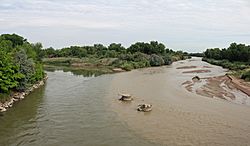Fountain Creek (Arkansas River tributary) facts for kids
Quick facts for kids Fountain Creek |
|
|---|---|

The confluence of Fountain Creek (right) and the Arkansas River near Pueblo, Colorado.
|
|
| Physical characteristics | |
| Main source | 38°59′48″N 105°01′44″W / 38.99667°N 105.02889°W |
| River mouth | Confluence with Arkansas 4,636 ft (1,413 m) 38°15′15″N 104°35′20″W / 38.25417°N 104.58889°W |
| Basin features | |
| Progression | Arkansas—Mississippi |
Fountain Creek is a stream in Colorado. It starts in Woodland Park and flows through El Paso County. The creek ends when it joins the Arkansas River near Pueblo. This creek is about 74.5 miles (120 kilometers) long. Long ago, it was known as the Fontaine qui Bouille.
Contents
Exploring the Fountain Creek Watershed
The area that drains into Fountain Creek is called its watershed. This watershed covers about 930 square miles (2,400 square kilometers). It stretches across Teller, El Paso, and Pueblo counties.
Where the Water Comes From
The watershed is surrounded by important natural landmarks. These include Pikes Peak, a famous mountain, and the Palmer Divide. Monument Creek is the biggest stream that flows into Fountain Creek. Other important streams are Sand Creek and Jimmy Camp Creek.
Fountain Creek and its smaller streams flow through several towns. These towns include Woodland Park, Green Mountain Falls, Palmer Lake, Monument, Manitou Springs, Colorado Springs, and Pueblo.
Changes in Elevation and Nature
The land along Fountain Creek changes a lot in height. It goes from the top of Pikes Peak, which is 14,115 feet (4,302 meters) high, down to 4,640 feet (1,414 meters) where it meets the Arkansas River. Because of these big changes in height, you can find many different types of plants and animals. The weather also changes a lot from one part of the creek to another.
Fun Things to Do Along the Creek
The Fountain Creek area offers many places for outdoor activities. You can visit parks like the Fountain Creek Regional Park and Nature Center in Fountain. There's also the Whitewater Kayak Park in Pueblo.
Trails and Wildlife
Along the creek, you'll find trails perfect for jogging, hiking, and bike riding. These trails are also great for watching local wildlife.
Future Learning Park
There are plans for a new place called the Fountain Creek Eco-Fit Education Park. This park will be in Colorado Springs. It will have fun, hands-on activities to help visitors learn about the creek. You might even be able to connect to areas along the creek using webcams!
Fishing in Fountain Creek
People who love to fish have started working together to help Fountain Creek. They want more people to know about fishing here. It's important to remember that if you fish here, it's usually "catch and release." This means you catch the fish and then let it go. This is because of the water quality.
Keeping Fountain Creek Clean
Making sure Fountain Creek has clean water is very important. Over the years, there have been challenges with water quality.
Past Water Issues
In the past, there were times when untreated water from sewers accidentally spilled into the creek. For example, in 1999, a large amount of untreated water flowed into the creek during a flood. This caused problems for the creek and nearby homes.
These spills led to higher levels of certain bacteria, like E. coli, in the water. This was a big concern, especially for towns downstream like Pueblo. Scientists studied the water to find out where the bacteria were coming from. They found that birds could be a source of some of the E. coli during summer.
Working Towards Cleaner Water
To fix these problems, the local utility company spent a lot of money to improve the sewer system. They built new pipes and special ponds to help manage water overflow. They also paid fines for the spills that happened. These efforts have helped to make the creek much cleaner.
Other Water Quality Challenges
Fountain Creek has also had issues with high levels of a natural element called selenium. This element can get into the water from the soil. E. coli levels can also be affected by wildlife, farm runoff, and stormwater. All these things can change how the creek flows and affect the plants and animals living there.
To address these issues, a group called the Fountain Creek Vision Task Force was created in 2006. This group works to improve water quality and create more recreational areas along the creek. They focus on making the water safe for fish and people, protecting wildlife, and managing stormwater.
Managing and Protecting the Creek
To ensure the long-term health of Fountain Creek, a special group was formed.
The Fountain Creek Watershed District
The Fountain Creek Watershed Drainage, Flood Control, and Greenway District was created in 2009. This group has nine board members who work to keep the waterways healthy and safe. They also want to create more opportunities for people to enjoy the creek.
Their projects include restoring wetlands, removing extra dirt from the creek, and improving water quality. They also work on managing floods and preventing erosion. The district aims to protect the homes of aquatic animals and wildlife. They even plan to add more trails for people to use.
Working Together for the Creek
The district works with many different groups and organizations. These include government agencies, universities, and the Fountain Creek Foundation. The Fountain Creek Foundation is a non-profit group that helps teach people about taking care of the creek for future generations. By working together, these groups help make sure Fountain Creek remains a valuable natural resource for everyone.
Images for kids


